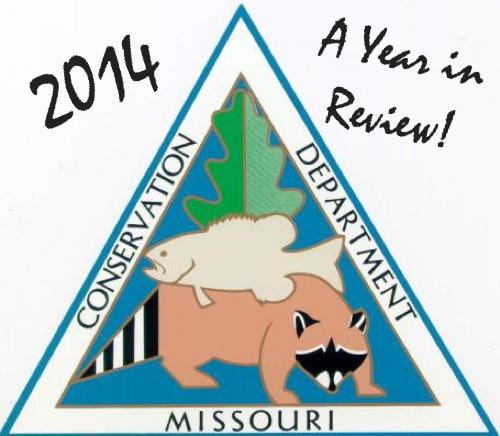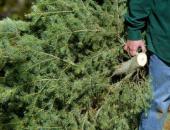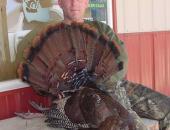Local News
A Year In Review with Missouri Conservation July - Dec 2014
January 02nd 2015 by Dee Loflin

Nature lovers found much to celebrate in 2014 and continued to expand the frontiers of conservation in the Show-Me State. Here is a brief summary of the first last month's of 2014's outdoor news stories.
JULY
Missouri Gov. Jay Nixon nominated former Conservation Federation of Missouri Executive Director Dave Murphy to a six-year term on the Conservation Commission.
A citizen alerted state conservation and agriculture officials to an emerald ash borer infestation in St. Charles County. It was the destructive insect’s first known infestation in the St. Louis area.
AUGUST
Thousands of people visited the Conservation Pavilion at the Missouri State Fair in Sedalia, peering into aquariums teeming with live fish and terrariums harboring exciting reptiles and amphibians. Staff from every conservation discipline were on hand to answer questions and present live programs on topics ranging from birds of prey to fish cleaning and cooking demonstrations.
MDC waterfowl biologists announced that duck-hunting prospects were extremely bright, with mallard numbers topping 10 million and blue-winged teal numbers at a record 8.5 million.
A Colorado man pleaded guilty to illegally trafficking paddlefish caviar obtained in Warsaw in 2012. The case was part of an undercover investigation called "Operation Roadhouse” led by U.S. Fish and Wildlife Service and MDC. To date, 240 out of 256 state charges have been completed against numerous individuals with over $61,000 in fines and court costs levied. The fine money went to the school districts in the counties where the violations were committed.
MDC released alligator gar reared at its Chesapeake Hatchery in Mount Vernon in a continuing effort to restore the species at Mingo National Wildlife Refuge and other parts of southeast Missouri. The alligator gar is by far the largest of gars and is one of the largest freshwater fishes in North America, sometimes reaching 10 feet in length and 350 pounds. The species was driven to near extinction partly because they were mistakenly believed to reduce numbers of sport fish.
SEPTEMBER
Missouri’s Sept. 1 opening of dove season fell on the Labor Day weekend, drawing larger than usual crowds of hunters at more than 100 conservation areas with fields specially managed for dove habitat.
Conservation agents helped rescue eight motorists stranded on or near Interstate 29 by a flash flood in Holt County and a school bus driver stranded on Route N north of Mound City.
MDC released a small-game hunting forecast showing quail, pheasant, and squirrel numbers increasing and rabbits likely to follow the trend. Results of the annual wild-turkey brood survey showed a poult-to-hen ratio 26 percent greater than the previous 10-year average.
MDC offered a new application for mobile devices that lets hunters and anglers buy permits and view permits purchased during the previous year. The MO Hunting app also allows deer and turkey hunters to telecheck their current harvests and view past telechecked harvests. Learn more at mdc.mo.gov/mobile/mobile-apps/mo-hunting.
About 30 MDC staff specially trained in fighting wildfires helped their western colleagues contain and extinguish wildfires in northern California, Oregon, Idaho, and Montana.
This year, Missouri hatcheries stocked more than 1.5 million trout in trout parks, Ozark streams, and winter fishing lakes. MDC warm-water hatcheries stocked more than 10 million fish in public waters including hybrid striped bass, walleye, muskie, channel catfish, paddlefish, hybrid sunfish, and hybrid striped bass.
OCTOBER
Self-guided driving tours to view wild elk at Peck Ranch and Current River Conservation Areas continued to grow as a tourist draw for the Ozarks, especially in the fall when bull elk bugle as part of their mating ritual. MDC estimates the Missouri elk herd has grown to more than 120 animals.
MDC’s Champion Tree Program certified several new state-record trees including a 95-foot tall black willow in St. Louis County, a 118-foot swamp chestnut oak near East Prairie, and an 82-foot-tall slippery elm in Neosho.
The Springfield Conservation Nature Center celebrated 25 years of serving millions of Missourians with special events and programs.
MDC and Ducks Unlimited hosted a dedication ceremony to celebrate the completion of a multi-year renovation project at Duck Creek Conservation Area in Bollinger, Stoddard, and Wayne counties. The project was part of the Golden Anniversary Wetlands Initiative launched in 2004 to revitalize managed wetland projects constructed in the mid-20th century.
MDC, Ducks Unlimited, Conservation Federation of Missouri, Missouri Conservation Heritage Foundation, Bass Pro Shops, and dozens of other conservation and hunting organizations partnered on the 480-page book, Waterfowl Hunting and Wetland Conservation in Missouri - A Model of Collaboration. For ordering information, visit mochf.org/2014/04/book-waterfowl-hunting-and-wetlands-conservation-in-missouri/.
The Conservation Commission approved regulations regarding the operation of hunting preserves and wildlife breeding facilities that hold captive deer. The regulations focused on preventing the spread of diseases, including chronic wasting disease. MDC received more than 40,000 public comments on the topic with most supportive of the regulation changes. The spread of chronic wasting disease could negatively impact Missouri deer hunting as well as deer-dependent businesses that support more than 12,000 Missouri jobs and generate over $1 billion in economic activity annually.
Hunters checked 5,691 turkeys during Missouri’s fall firearms turkey season Oct. 1-31.
Working with conservation partners and private landowners MDC reintroduced Topeka shiners to the Spring Creek watershed in northeast Missouri. This small prairie minnow was once common in Missouri and is designated as a federally endangered species. The minnows were released on Union Ridge Conservation Area and designated as a “non-essential experimental” population, which allows landowners and managers to continue with normal agricultural and land management practices.
NOVEMBER
Building on a strong opening weekend harvest, Missouri hunters checked 167,205 deer during firearms deer season Nov. 15-25. The number exceeds last year’s harvest of 157,273. Top harvest counties were Howell with 3,418 deer checked, Franklin with 3,338, and Texas with 3,170.
The Department gathered public comments for dozens of conservation areas, river accesses and nature centers throughout the year. In November, this included an open house at James A. Reed Memorial Wildlife Area. Hundreds of comments received are being used to help develop management plans at these popular destinations. To comment on area management plans, visit mdc.mo.gov/areaplans.
DECEMBER
The Department started a five year study in northwest and southcentral Missouri on white-tailed deer to determine the impact of large-scale habitat changes, hunting pressure, movement patterns, and survival rates. MDC staff are working with landowners to capture and fit deer with radio collars. Information from the study will help staff better manage our state’s valuable deer herd.
Hunters checked 9,107 deer during the antlerless portion of Missouri’s firearms deer season, bringing this year’s tally to more than 240,000. Remaining portions include alternative-methods portion Dec. 20-30 and the late youth portion Jan. 3-4.
Last Updated on January 02nd 2015 by Dee Loflin
https://showmetimes.com/Blogpost/utb0/A-Year-In-Review-with-Missouri-Conservation-July--Dec-2014





